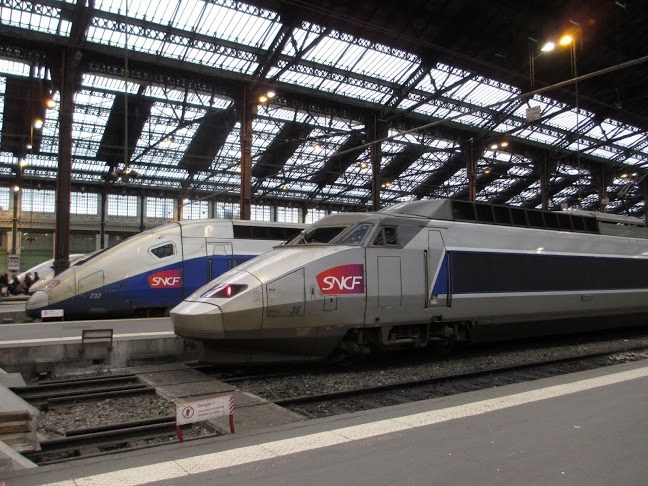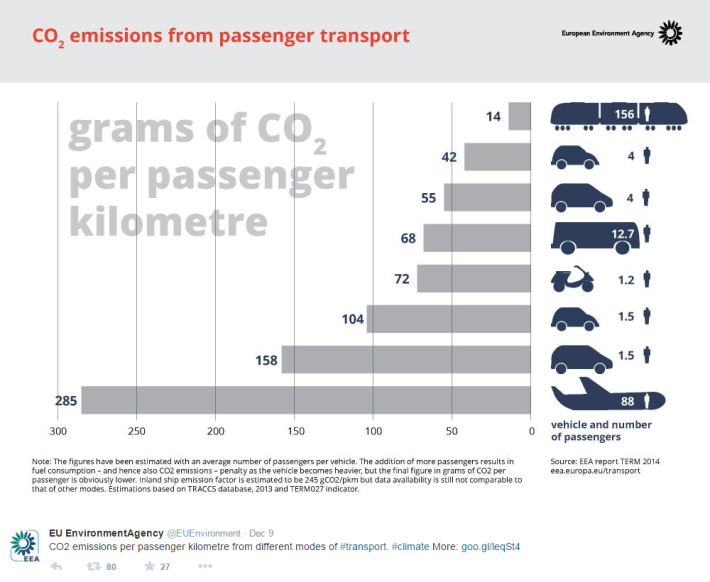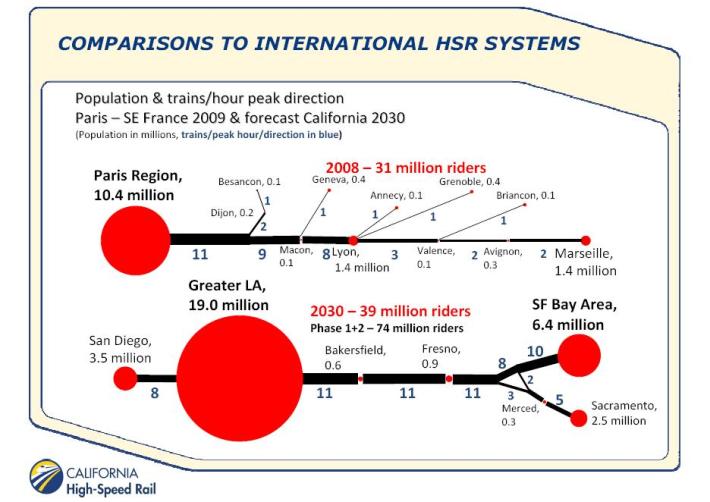High Speed Rail Will Take People out of Electric Cars?
4:31 PM PST on February 7, 2019

HSR in Paris. Photo: Ryan Stern
An editorial from the ExxonMobil and Koch-funded Reason Foundation made the rounds this morning with the claim that "High-speed rail would provide little or no reduction in overall greenhouse-gas emissions." The piece was penned by Marc Joffe, a senior policy analyst at Reason.
From the Mercury News, where it ran:
Since voters approved high-speed rail in 2008, electric car technology has improved greatly, and state policies have accelerated the transition to zero-emission vehicles. Last year, then-Gov. Jerry Brown signed an executive order setting a goal of having 5 million electric vehicles on the state’s roads by 2030.
By the time the first bullet train pulls out of San Jose’s Diridon Station it may well displace more electric vehicle trips than trips by cars relying on fossil fuels. If our electricity comes from renewable sources by then, high-speed rail would be replacing car trips that don’t produce greenhouse-gas emissions.
There are 14.5 million cars in California. Only about 500,000 are electric. Even if Brown's objectives are reached in 2030, the vast majority of automobiles won't be electric. So, yes, transferring motorists to a train will still reduce CO2.
At least they're conceding (presumably inadvertently) that HSR will take cars off the road. That might be because cars, electric or otherwise, get caught in traffic jams, are far more dangerous, and don't travel at 200 mph. HSR trains also don't waste energy carrying fuel or heavy batteries along for the ride, since the electricity goes directly from off-board power stations to the train's motors via an overhead wire. So whatever's under the hood, cars always use many multiples more energy to move the same number of passengers.

But Reason wants us to simultaneously believe trains will run empty and take electric cars off the road.
Joffe trots out the usual nonsense that annual ridership won't be what is projected, because at 38 million it "...would be more than triple the 2017 ridership throughout Amtrak’s busy Northeast Corridor connecting Washington, New York and Boston. It seems inconceivable that California’s high-speed rail line could quickly outperform a century-old route that serves a more-densely populated area."
First of all, 38 million is not triple the ridership on the Northeast Corridor, which carries lots of trains run by railroads other than Amtrak. Just one of them, Metro-North, hauls around 40 million riders annually between New York and New Haven.
But he's right about one thing: the Northeast Corridor is old--it was finished in 1917. That means all those trains back east are forced to run on tight curves and outdated infrastructure. Train and track technology have advanced as much as any other tech in the last 100 years and California's future HSR trains, running on modern rails with modern signals, bridges, tunnels, etc. will be roughly 100 mph faster than anything in the Northeast.
A better comparison for California's project is to look at a modern HSR system, such as the French TGV train shown in the lead image, in a country with similarly sized cities and travel times:

Joffe also makes the absurd complaint that the construction of HSR will produce CO2. Of course it will. What are they suggesting? The construction of more roads and airports produces CO2 too--but those modes then continue to produce greenhouse gases. The point is to reduce ongoing CO2 emissions, of which our transportation sector--because it's based on cars and planes--is the biggest contributor.
None of this is new. Six years ago, Streetsblog L.A. called out Reason's nonsensical numbers for the Exposition Line Light Rail between downtown Los Angeles and Santa Monica. In that case, Reason claimed the rail line, when only half of it was open, was a failure because it didn't meet ridership projections for the full line. Except that as soon as the second half of the system opened it exceeded ridership projections--seven years ahead of schedule.
But sowing misinformation about rail projects that can divert people from cars and planes is what the Reason Foundation does for a living. Obviously, the CEO of ExxonMobil or the Koch Brothers can't write an editorial bashing HSR and expect anyone to take it as more than an attempt to stymie non-oil-consuming modes of transportation.
That's why they pay Reason to do it.
Read More:
Stay in touch
Sign up for our free newsletter
More from Streetsblog San Francisco
SFMTA Starts West Portal Outreach
Agency presents plans to block traffic from crossing in front of the train station



